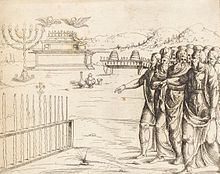In the culture of the
Israelites, the rod (
Hebrew: מַטֶּה
maṭṭeh) was a natural symbol of authority, as the tool used by the
shepherd to correct and guide his
flock (
Psalm 23:4). Moses's rod is, in fact, cited in
Exodus 4:2 as carried by him while he tended his sheep; and later (Exodus 4:20) becomes his symbol of authority over the Israelites (
Psalm 2:9,
Psalm 89:32,
Isaiah 10:24 and 11:4,
Ezekiel 20:37). The rods of both Moses and Aaron were endowed with miraculous power during the
Plagues of Egypt (Exodus 7:17, 8:5, 8:16-17, 9:23, and 10:13);
God commanded Moses to raise his rod over the
Red Sea when it was to be parted (Exodus 14:16) and in prayer over Israel in battle (Exodus 17:9); Moses
brings forth water from a stone using his rod (Exodus 17:2-6).
Aaron's rod, however, is cited twice as exhibiting miraculous power on its own, when not physically in the grasp of its owner. In
Exodus 7 (
Parshat Va'eira in the
Torah),
God sends Moses and Aaron to the Pharaoh once more, instructing Aaron that when the Pharaoh demands to see a miracle, he is to "cast down his rod" and it will become a serpent. When he does so, the Pharaoh's sorcerers counter by similarly casting down their own rods, which also become serpents, but Aaron's rod swallows them all. "The Pharaoh's heart is stubborn" and he chooses to ignore this bit of symbolic warning, and so the
Plagues of Egypt ensue. Notably, this chapter begins with God telling Moses, "Behold, I have made you as God to the Pharaoh and your brother Aaron will be your prophet." As God transmits his word through his prophets to his people, so Moses will transmit God's message through Aaron to the Pharaoh. The prophet's task was to speak God's word on God's behalf. He was God's "mouth". (Exodus 4:15-16)
 The Blossoming of Aaron's Rod
The Blossoming of Aaron's Rod, etching by
Augustin Hirschvogel
In Numbers 16,
Korah's rebellion against Moses's proclamation of the
tribe of Levi as the
priesthood has been quashed and the entire congregation's ensuing rebellion has resulted in a
plague, ended only by the intercession of Moses and Aaron. In order to "stop the complaints" of the Israelites, God commands that each of the
Twelve Tribes provide a rod; and only that of the tribe chosen to become priests will miraculously sprout overnight. Aaron provides his rod to represent the tribe of Levi, and "
it put forth buds, produced blossoms, and bore ripe almonds" (Numbers 17:8), as an evidence of the exclusive right to the priesthood of the tribe of Levi. In commemoration of this decision it was commanded that the rod be put again "before the testimony" (Numbers 17:10).
[1]
A book of the Christian Bible seems to assert (Hebrews 9:4) that the rod was kept in the
Ark of the Covenant.







 see why it says not to judge. This is the Pharisees leaven that Jesus speaks of
see why it says not to judge. This is the Pharisees leaven that Jesus speaks of




